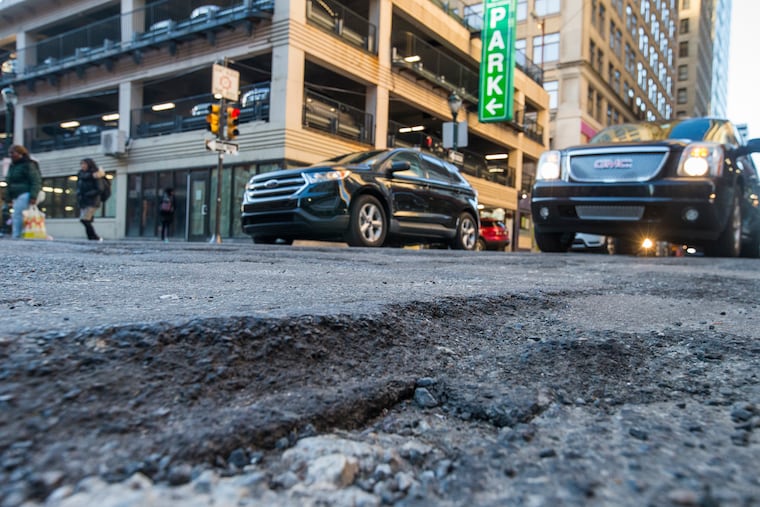Why are potholes such a perpetual problem? Weather, poor road maintenance, and randomness.
Patching potholes is akin to putting Band-Aids on gaping wounds, experts say.

Steve Lorenz received a call from his wife one day a while back, and she was not particularly happy. Her car had an encounter with a pothole. The pothole won. It punctured a tire and stopped her cold.
She “yelled at me,” Lorenz recalled. “I told her she shouldn’t have driven through it.”
Lorenz has an intimate familiarity with the hazards of potholes, if not the politics of marriage. He is Philadelphia’s chief highway engineer, and his job is to get those things fixed.
So far, Lorenz’s crews have filled about 15,000 potholes this year, largely the fallout from a snowy February, and after another freeze-thaw weekend with wet roads and temperatures falling into the 20s, they likely will be chasing thousands more during the next several days.
New Jersey, where portions of Routes 42, 322, and 55 appeared to be in better shape last week than the Schuylkill Expressway and the Blue Route in Pennsylvania, repaired close to 30,000 statewide just in the first 15 days of March, and PennDot’s Philadelphia region already has gone through better than 1,600 tons of asphalt since Jan. 1.
» READ MORE: What Philly’s most pothole-riddled streets have in common
Lorenz described a perennial ordeal that evoked Sisyphus, the unfortunate mythological character who was sentenced to an eternity of pushing a boulder uphill.
“It’s a perpetual problem,” he said. And a perpetual hazard to motorists, pedestrians, and bicyclists.
So if drug companies were able to develop a coronavirus vaccine on amazingly short notice, how come no one has found a cure for the common pothole?
“There is no silver bullet,” said Yusuf Mehta, professor in the department of civil and environmental engineering at Rowan University. He runs the school’s Center for Research and Education in Advanced Transportation Engineering Systems, which is intensely involved in paving research.
The problem is far deeper than the average road gash, he adds. In essence, road crews are affixing Band-Aids to gaping wounds.
How they form
Bearing the loads of tons of vehicles and living with the vicissitudes of weather and drainage systems, cracks inevitably form on road surfaces. Water from rain, snow, and ice melt oozes into those openings.
When temperatures fall below freezing, water changes to ice and expands and dislodges the solid material. (Think how the metal bulges when a canned beverage is left in a freezer.)
» READ MORE: Sick of potholes? Blame your elected officials who don’t care about your quality of life | Opinion
The road surface further weakens with each freeze-thaw cycle, exacerbated by all those load-bearing wheels.
Road crews rely heavily on reports from the public to locate pothole trouble spots. Since Jan. 1, PennDot’s Philly region has fielded about 2,000 of them, said spokesperson Brad Rudolph.
Lorenz said that if his crews spot other potholes on their way to a job, they will fill those along the way.
He said the utter randomness of road damage was especially maddening.
“There’s no rhyme or reason as to why this pothole is forming here, and not five or six feet away,” he said.
When will they go away?
Possibly never, Mehta and other experts say.
Roads have a problem that humans can relate to: aging. Potholes mostly form on “older” paved surfaces “that have not been properly maintained,” said Charles Goodheart, executive director of the Pennsylvania Asphalt Pavement Association.
“If you can maintain your transportation assets, like asphalt pavements, on a set cycle, and then replace them at the end of their designed life span, you would see very few pavement distresses, including potholes,” he said.
Why is that so hard? “As with most things infrastructure,” Goodheart said. “It comes down to money.”
» READ MORE: Potholes shouldn’t be forever | Editorial
Typically, a road would be designed to last 20 years, said Mehta, whose lab is working on new generations of paving materials under research contracts from the New Jersey Department of Transportation, the Department of Defense, Federal Highway Administration, and private companies.
But most roads likely would need resurfacing after 15 years. Those that last 20 to 25 years are “rarities,” he said. In Philly, streets ideally should get a redo every eight to 10 years, said Lorenz. But some have been waiting 15 to 20 years.
And Mehta said that he does not envision the day when anyone produces pothole-proof paving. The best solution, he said, would be frequent systemwide resurfacing. But, he said, that may require motorists to agree to pay steep excise taxes on gasoline, which is unlikely. Besides, over time, electric cars ultimately could reduce gas consumption.
While you’re waiting
Lorenz recommends that anyone who spots a pothole should call 311, and not assume that someone else has already reported it.
For potholes on Pennsylvania state highways, call 1-800-FIX-ROAD or go to customercare.penndot.gov. In New Jersey, call 1-800-POTHOLE or go to report potholes.